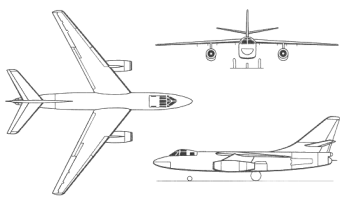



The Douglas B-66 Destroyer was a land-based adaptation of the US Navy's A3D Skywarrior, designed due to the increased need for a high performance tactical bomber with reconnaissance capability. Unlike its navalized counterpart, the B-66 lacked features such as folding wings and arrester gear but the changes went further than that: a new wing and redesigned fuselage was installed in addition to a completely different equipment fit and engines. While the A3D flew in combat during the Vietnam War, the B-66 did not although reconnaissance variants were used in that conflict as well as during the Cuban Missile Crisis. The other major role for the Destroyer was as an electronic countermeasures platform: it too was used to some extent in Vietnam with others being based in Germany throughout the first half of the 1970s before being retired in 1975.
Although a prototype per se was not flown, the first pre-production RB-66A unit was flown on 28 June 1954 and was followed by the production RB-66B. Both had multiple cameras installed while retaining bombing capability but their intended role was for nocturnal photo-reconnaissance. Later, the B-66B was the only pure bomber variant although even these were later converted to other roles. The first ECM platform version was the RB-66C which had a pressurized compartment for four equipment officers in the bomb bay while the WB-66D was used to collect weather data and the last converted ECM units were known as the EB-66B, C, and E.
 | |
| Design | B-66B |
| Name | Destroyer |
| Type | Light Bomber |
| Year | 1956 |
| Crew | 3 |
| Dimensions | |
| Length | 22.91 m |
| Height | 7.188 m |
| Wing Span | 22.10 m |
| Wing Area | n/a |
| Weight | |
| Empty | 19,296 kg |
| Maximum | 37,649 kg |
| Wing Loading | 519.5 kg/m² |
| Performance | |
| Speed | 1,015 km/h |
| Ceiling | 12,009 m |
| Range | 3,975 km |
| Powerplant | |
| Engine | 2 x J71-A-11/13 Allison 4,627 kgf |
| Thrust/Weight | 0.44 |
| Armament | |
| Guns | 2 x 20-mm |
| Payload | 6,804 kg |
| Production | |
| Built | 72 |
| Total | 293 |